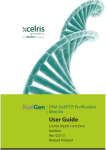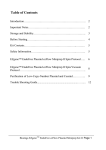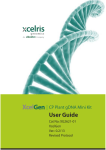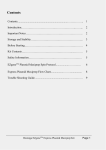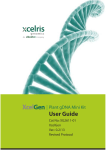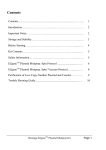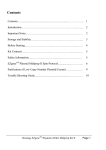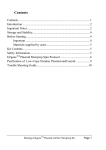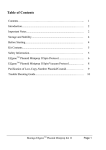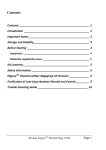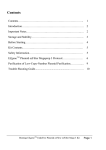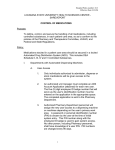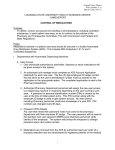Download Manual - Xcelris Genomics
Transcript
Plasmid Mini Kit User Guide Cat No: XG1211-01 XcelGen Ver.: 0.2/13 Revised Protocol Plasmid Mini Kit Table of Contents Introduction ............................................................................................................. 02 Storage and Stability ............................................................................................. 02 Important Notes ..................................................................................................... 02 Kit Contents .............................................................................................................. 04 Before Starting ........................................................................................................ 04 Safety Information ................................................................................................. 04 Plasmid Mini Kit Spin Protocol .......................................................................... 05 Plasmid Mini Kit Spin/ Vacuum Protocol ....................................................... 07 Purification of Low-Copy-Number Plasmid/Cosmid ................................. 07 Purification of plasmid >12kb ........................................................................... 07 Troubleshooting Guide ........................................................................................ 09 Related Products .................................................................................................... 10 Limited Use and Warranty ...................................................................................10 01 Plasmid Mini Kit Introduction Key to the kit is our proprietary DNA binding systems that allow the high efficient reversible binding of DNA to the mini column while proteins and other impurities are removed by wash buffer. Nucleic acids are then eluted with sterile water or elution buffer. This kit is designed for fast and efficient purification of plasmid DNA from 1 to 4ml of E. coli culture. The mini column has a plasmid DNA binding capacity of 50 g. The yield from 1 ml culture is typically around 8 to 12 g. The purified DNA is ready for downstream applications such as cloning/subcloning, RFLP, sequencing and transfection of robust cells such as HEK293 cells. Storage and Stability Buffer A1 should be stored at 4°C once RNase A is added. All other materials can be stored at room temperature (22-25°C). All kit components are stable up to 12 months. Important Notes Plasmid Copy Numbers: The yield of plasmid DNA depends on the origin of the replication and the size of the plasmid. The protocols are optimized for high copy number plasmid purification. For low copy number plasmids, both the culture volume and the buffer volume need to be scaled up 2 times. Please contact our customer service for further information and reference Table 1 for the commonly used plasmids. Table 1: Commonly used plasmids and expected yield. Plasmid Origin Copy Numbers Expected Yield (µg/ml) PSC101 PSC101 5 0.1-0.2 pACYC P15A 10-12 0.4-0.6 pSuperCos pMB1 10-20 0.4-1 pBR322 pMB1 15-20 0.6-1 pGEMR Muted pMB1 300-400 6-7 pBluescriptR ColE1 300-500 6-8 pUC Muted pMB1 500-700 8-12 02 Plasmid Mini Kit Host Strains: The strains used for propagating plasmid have significant influence on yield. Host strains such as Top 10 and DH5 yield high-quality plasmid DNA. endA+strains such as JM101, JM110, HB101, TG1 and their derivatives, normally have low plasmid yield due to either endogenous endonucleases or high carbohydrates released during lysis. We recommend transform plasmid to an endA- strain if the yield is not satisfactory. Please reference Table 2 for the endA information. Table 2: endA strains of E. Coli. EndA- Strains of E. Coli DH 5 DH1 DH 21 JM106 JM 109 SK2267 SRB XLO TOP10 DH108 JM103 JM107 SK1590 MM294 Stbl2 XL1-Blue BJ5182 DH20 JM105 JM108 SK1592 Stbl4 XL10-Gold Select96 EndA+ Strains of E. Coli C600 JM110 RR1 ABLE® C CJ236 KW251 P2392 BL21(DE3) HB101 TG1 TB1 ABLE® K DH12S LE392 PR700 BL21(DE3) pLysS JM101 JM83 TKB1 HMS174 ES1301 M1061 Q358 BMH 71-18 All NM strains All Y strains Optimal Cell Mass (OD600 x ml of Culture): This procedure is designed for isolating plasmid grown in standard LB medium (Luria Bertani) for 12-16 hours to a density of OD600 2.0 to 3.0. If rich medium such as TB or 2xYT are used, make sure the cell density doesn t exceed 3.0 (OD600). A high ratio of biomass over lysis buffers result in low DNA yield and purity. The mini column has an optimal biomass of 10-15. For example, if the OD600 is 3.0, the optimal culture volume should be 1-5 ml. For over amount of cell numbers, either reduce the biomass or scale up the volumes of Buffer A1, B1 and N1. Culture Volume: Use a flask or tube 4 times bigger in volume than the culture medium to secure optimal condition for bacteria growth. Don t exceed the maximum culture volume suggested in the protocol. Incomplete lysis due to over amount of bacterial culture results in lower yield and less purity. 03 Plasmid Mini Kit Kit Contents Product XG1211-00 XG1211-01 Preps 4 50 Columns 4 50 Buffer A1 1.2 ml 15 ml Buffer B1 1.2 ml 15 ml Buffer N1 1.6 ml 20 ml Buffer BL 1.8 ml 22 ml Buffer KB 3 ml 30 ml DNA Wash Buffer* 2 ml 15 ml Elution Buffer 600 µl 10 ml RNase A (20 mg/ml) 0.2 mg (10 µl) 1.5 mg (75 µl) User Manual 1 1 Before Starting Prepare all components and get all necessary materials ready by examining this instruction booklet and become familiar with each steps and pay special attention to the followings. Important RNase A: 20mg/ml. It is stable for more than half a year when stored at room temperature. Spin down RNase A vial briefly. Add the RNase A solution to Buffer A1 and mix well before use. Store at 4°C. Add 8ml (XG1211-00) or 60 ml (XG1211-01) or 96-100% ethanol to each DNA Wash Buffer bottle before use. Buffer B1 and Buffer BL precipitates below room temperature. It is critical to warm up the Buffer at 50°C to dissolve the precipitates before use. Keep the cap tightly closed for Buffer B1 and Buffer BL after use. Carry out all centrifugation at room temperature. Safety Information Buffer N1 contains acidic acid, wear gloves and protective eyewear when handling. Buffer N1 and KB contains chaotropic salts, which may form reactive compounds when combines with bleach. Do not add bleach or acidic solutions directly to the preparation waste. 04 Plasmid Mini Kit Plasmid Mini Kit Spin Protocol 1. Inoculate 1-4ml LB containing appropriate antibiotic with a fresh colony from a freshly streaked selective plate. Incubate at 37°C for 14-16 hours with vigorous shaking. Note: Prolonged incubation (> 16 hours) is not recommended since the E.coli starts to lyse and the plasmid yields may be reduced. Note: Do not grow the culture directly from the glycerol stock. Note: This protocol is optimized for E. coli strain cultured in LB medium. When using TB or 2xYT medium, special care needs to be taken to ensure the cell density doesn t exceed 3.0 (OD600). Buffers need to be scaled up proportionally if over amount of cultures are being processed. 2. Harvest the bacterial culture by centrifugation for 1 min at 10,000 rpm. Pour off the supernatant and blot the inverted tube on a paper towel to remove residue medium. Remove the residue medium completely. Note: Residue medium will cause, Poor cell lysis and thus lower DNA yield. 3. Add 250 l Buffer A1 (Add RNase A to Buffer A1 before use) and completely resuspend bacterial pellet by vortexing or pipetting. Note: Complete resuspension is critical for bacterial lysis and lysate neutralization. 4. Add 250 l Buffer B1, mix gently by inverting the tube 10 times (do not vortex), and incubate at room temperature for 5 minutes. Note: Do not incubate for more than 5 minutes. Note: Buffer B1 precipitates (cloudy look) below room temperature. Warm up Buffer B1 at 50°C to dissolve precipitation before use. 5. Add 350 l Buffer N1, mix completely by inverting/shaking the vial for 5 times and sharp hand shaking for 2 times. Note: Incubating the lysate in ice for 1 min will improve the yield. Note: It is critical to mix the solution well. If the mixture still appears conglobated, brownish or viscous, more mixing is required to completely neutralize the solution. 6. Centrifuge the lysate at 13,000 rpm for 10 minutes at room temperature. Note: If the lysate doesn t appear clean, reverse the tube angle, centrifuge for 5 more minutes and then transfer the clear lysate to DNA column. 05 Plasmid Mini Kit 7. Add 400 l of Buffer BL into the spin column (provided), incubate at room temperature for 2 minutes, centrifuge at 12000 rpm for 2 minutes and discard the flow through. The column is ready and will work well for binding DNA. 8. Carefully transfer the clear lysate into a DNA column with a collection tube, avoid the precipitations, spin at 13,000 rpm for 1 minute, discard the flow-through and put the column back to the collection tube. 9. Add 500 l Buffer KB into the spin column, centrifuge at 13,000 rpm for 1 minute. Remove the spin column from the tube and discard the flow-through. Put the column back to the collection tube. Note: This step is important to remove residual protein contaminations especially for endA+strains and be highly recommended for high quality plasmid DNA. 10. Add 650 l DNA Wash Buffer (Add ethanol to DNA wash buffer before use) into the spin column, centrifuge at 13,000 rpm for 1 minute at room temperature. Remove the spin column from the tube and discard the flow-through. Repeat step 10 to improve the recovery. 11. Reinsert the spin column, with the lid open, into the collection tube and centrifuge for 2 minutes at 13,000 rpm. Note: Residual ethanol can be removed more efficiently with the column lid open. It is critical to remove residual ethanol completely. 12. Carefully transfer the spin column into a sterile 1.5ml microfuge tube and add 50100 l sterile ddH2O or Elution buffer into the center of the column and let it stand for 2 minutes. Elute the DNA by centrifugation at 13,000 rpm for 1 minute. Reload the eluate into the column and elute again. Note: It is recommended to use elution buffer instead of ddH2O. Note: If ddH2O is applied, please make sure the pH is no less than 7.0 (7.0-8.5 is preferred). NaOH could be used to adjust the pH of ddH2O. Note: The DNA is ready for downstream applications such as cloning/subcloning, RFLP, library screening, in vitro transfection, sequencing, transfection of robust cells such as HEK293 cells. Note: It is highly recommended to remove the endotoxin (XG1212-01) if the DNA is used for endotoxin-sensitive cell lines, primary cultured cells or microinjection. 13. The DNA concentration can be calculated as follows :Concentration ( g/ml) = OD260nm X 50 X dilution factor 06 Plasmid Mini Kit Plasmid Mini Kit Spin/Vacuum Protocol 1. Set up the vacuum manifold according to manufacture s instruction and connect the column to the manifold. 2. Carry out step 1-7 on Page 6 in previous protocol. 3. Carefully transfer the clear lysate to the DNA column and turn on the vacuum to allow the lysate pass through the column. 4. Add 500 l Buffer KB into the spin column and allow the lysate pass through the column by vacuum. Note: This step is important to remove residual protein contaminations especially for endA+strains and be recommended for high quality plasmid DNA. 5. Add 650 l of DNA Wash Buffer to the column and allow the vacuum to draw the liquid through the manifold. Turn o the vacuum. Repeat step 5 to improve the recovery. 6. Transfer the column, with the lid open, to a 1.5 ml collection tube and centrifuge at 13,000 rpm for 2 minutes. 7. Carefully transfer the spin column into a clean 1.5 ml microfuge tube and add 50100 l (>50 l) Sterile ddH20 or Elution Buffer into the column and let it stand for 2 minutes. Elute the DNA by centrifugation at 13,000 rpm for 1 minute. Reload the eluate into the column and elute again. Note: It is recommended to use Elution Buffer instead of ddH20 Note: The DNA is ready for downstream applications such as cloning, RFLP, library screening, in vitro translation, sequencing and transfection of robust cells such as HEK293 cells. 07 Plasmid Mini Kit 1 2 3 4 5 L Fig: Agarose gel analysis of plasmid DNA purified with XcelGen Plasmid mini Kit Lane 1: pbluescript II Lane 2: pUC 18 Lane 3: pBR 322 Lane 4: pGEM Lane 5: pET 43.1 Lane L: 1 kb ladder Purification of Low-Copy-Number Plasmid/Cosmid The yield of low copy number plasmid is normally around 0.1 1 g /ml of overnight culture. For isolating low copy number or medium copy number plasmid DNA, use the following guideline: Culture volume: Use 2 x volumes of the high copy number culture. Use 2 x volumes of the Buffer A1, Buffer B1 and Buffer N1. Additional Buffers can be purchased from XcelGen. Use same volume of DNA Wash Buffer and Elution Buffer. Purification of plasmid >12kb For isolating plasmid DNA > 12 kb, use the following guideline: Culture volume: Use 2 x volumes of the culture. Use 2 x volumes of the Buffer A1, Buffer B1 and Buffer N1. Additional Buffers can be purchased from XcelGen. Use same volume of DNA Wash Buffer and Elution Buffer. Pre-warm the Elution Buffer at 65-70°C and let the column stand for 5 minutes after adding Elution Buffer. 08 Plasmid Mini Kit Troubleshooting Guide Problems Possible Reasons Suggestions Low Yield Poor Cell lysis. Resuspend pellet thoroughly by votexing and pipetting prior to adding Buffer B1. Make fresh Buffer B1if the cap had not been closed tightly. (Buffer B1: 0.2M NaOH and 1%SDS). Low Yield Bacterial culture overgrown or not fresh Grow bacterial culture upto 12-16 hours. Spin down cultures and store the pellet at -20°C if the culture is not purified the same day. Do not store culture at 4°C over night. Low Yield Low copy-number plasmid Increase culture volume and the volume of Buffer A1, B1, N1 as instructed on page 8. No DNA Plasmid lost in Host E. coli Prepare fresh culture. Genomic DNA contamination Over-time incubation after adding Buffer B1. Do not vortex or mix aggressively after adding Buffer B1. Do not incubate more than 5 minutes after adding Buffer RNA contamination RNase A not added to Buffer A1. Add RNase A to Buffer A1. Plasmid DNA floats out of wells while running in agarose gel, DNA doesn t freeze or smell of ethanol Ethanol traces were not completely removed from column. Make sure that no ethanol residue remains in the silicon membrane before elute the plasmid DNA. Re-centrifuge or vacuum again if necessary. No phase partitioning after centrigugation Temperature is lower than 23°C. Make sure the temperature is greater than 23°C for centrifugation or incubate the sample at 60°C for 5 min and then perform centrifugation 09 Plasmid Mini Kit Related Products 1. 2. 3. 4. 5. EndoFree plasmid mini kit (XG1212-01) 96 Well Plasmid Isolation Kit (XG1201-96) DNA Gel/PCR Purification Miniprep kit (XG3511- 01/XG3514) Premix Taq V2.0 (XG334A) Agarose (XGA-100) Limited Use and Warranty This product is intended for in vitro research use only. Not for use in human. This product is warranted to perform as described in its labeling and in XcelGen s literature when used in accordance with instructions. No other warranties of any kind, express or implied, including, without limitation, implied warranties of merchantability or fitness for a particular purpose, are provided by XcelGen. XcelGen s sole obligation and purchaser s exclusive remedy for breach of this warranty shall be, at the option of XcelGen, to replace the products, XcelGen shall have no liability for any direct, indirect, consequential, or incidental damage arising out of the use, the results of use, or the inability to use it product. For technology support or learn more product information, please visit our website at www.xcelrisgenomics.com 10 Product & Services Quality Kits made by perts • Plasmid DNA Isolation Kits • Genomic DNA Extraction Kits • RNA Extraction Kits • Polymerase • DNA Ladders • DNA Markers • Premix Taq • dNTP's • RAPD kits • Agarose • Glycerol • Tms NA Stabilizers & RNA Protectant solutions Prime Oligo Synthesis & Purification Services • 10 nmole • 25 nmole • 50 nmole • 100 nmole • 200 nmole • 1000 nmole N T NGS Services • Denovo Genome Sequencing • Whole Genome Resequencing • GBS/RAD Sequencing • Exome Sequencing • Amplicon Sequencing • Whole Transcriptome Analysis/RNA-Sequencing • Small RNA Sequencing • Metagenomics • Metatranscriptomics • ChIP Sequencing • Mitochondrial Sequencing • Next Generation Genomic Services on Illumina MiSeq • Genotyping by Sequencing • Tilling/Ecotilling using NGS • Genome Database development Services NGS Bioinformatics • In silico Primer Design • Microarray Analysis • Metagenomics • Physical, Genetic and QTL mapping • Assembly and annotation of prokaryotic and eukaryotic genome • Genome Mapping and SNP discovery • Transcriptome discovery and analysis • sRNA analysis and discovery Seq Sanger Sequencing Services • Plasmid /PCR Sequencing Services • r-E. coli Culture Sequencing Services • Primer Walk Sequencing Services • Microbial Identification Service • Multilocus Sequence Typing Customised Services • SNP Genotyping by SNaPshot Assay • Microsatellite Genotyping • Golden Gate Assays and Arrays • Gene Expression on Real Time PCR • Gene expression on Agilent / Microarray / Affymetix • Library construction Xcelris Labs Limited Old Premchand Nagar Road, Opp. Satyagrah Chhavani, Bodakdev, Ahmedabad-380015, India. Tel.: +91-79-66197777 / Fax: +91-79-66309341 Website: www.xcelrisgenomics.com E-mail: [email protected]












